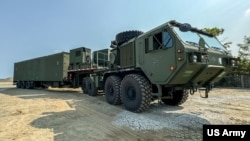Beijing officials are decrying the deployment of U.S. medium-range missiles in the Asia-Pacific region for the first time since the Cold War.
China's Foreign Ministry spokesman Lin Jian, at a regular press briefing Thursday, said China "expresses grave concern” and "strongly opposes the U.S. ... strengthening forward deployment at China's doorstep to seek unilateral military advantage."
The U.S. military on Monday confirmed it had on April 11 placed a mid-range capability missile system on northern Luzon in the Philippines as part of joint military exercises called Salaknib 24. It’s the first time since the Cold War that the U.S. deployed such a system in Asia.
The half military-funded Stars and Stripes identified the system as the Army’s newest Typhon launcher, a land-based system that can fire various missiles, including the SM-6 supersonic missile, with a range of about 450 kilometers, and the Tomahawk cruise missile, with a maximum range of 2,500 kilometers.
That means the system is capable of covering not only the entire Taiwan Strait and the Philippines’ Luzon Strait but also the most important cities on China's eastern coast and Chinese military bases in and around the South China Sea.
Stars and Stripes described the system as “temporarily deployed” for the exercises. Janes, an open-source defense and intelligence company, quoted a Philippine Army spokesman saying the missile system will be used by the army only during exercises Salaknib 24, which ends April 19, and the upcoming Balikatan 24, which starts April 22 and finishes May 10.
Nonetheless, analysts say the missile placement is noteworthy.
"The deployment of these ground-based missiles into the Pacific is a significant development," says Eric Heginbotham, a principal research scientist at MIT's Center for International Studies. "For example, in an invasion of Taiwan, a Chinese amphibious fleet would effectively have to anchor off a landing area in Taiwan. Its location would be known. And these maritime strike Tomahawks could go to work, target the fleet, and sink part of it," he tells VOA.
Beijing considers self-ruled and democratic Taiwan a renegade province that must one day reunite with the mainland, by force if necessary.
Wilson Beaver, a policy adviser for defense budgeting at The Heritage Foundation, tells VOA that for now, the U.S. is only deploying one battery, which likely won’t change Chinese military planning unless it becomes more permanent.
"... Long-term, this new system could seriously complicate Chinese military planning were it to be deployed to the theater in greater numbers by forcing Chinese planners to account for air, sea, and ground-based American missiles capable of destroying ships attempting an invasion of Taiwan. Ideally, this would be sufficient to deter China from the attempt," he notes.
The U.S. military last year announced plans to deploy the missile defense system in the Pacific this year, but their destination was the subject of speculation.
Commander of the U.S. Army Pacific Command Charles Flynn earlier this month told Korean media, including Yonhap News Agency, that the missiles would soon be deployed, though he did not disclose the specific times and places.
China has been warning against the plan.
Chinese Defense Ministry spokesperson Wu Qian last week called it "a dangerous move that will seriously threaten the security of regional countries and undermine regional peace and stability."
The Chinese navy has rapidly grown in the past decade to become the world's largest navy.
The U.S. Defense Department, "Military and Security Developments Involving the People's Republic of China," in October estimated China has more than 370 ships and submarines — more than the U.S.’s less than 300. The U.S. plans to increase its fleet to 435 by 2030.
China’s large number of vessels and modernizing navy has raised concerns that it could have an advantage in the event of conflict with Taiwan or over territorial disputes in the South China. Beijing claims most of the Sea, putting it in conflict with Brunei, Indonesia, Malaysia, the Philippines, Taiwan and Vietnam. As China's navy grows, the U.S. fleet is on a “downward trajectory,” maritime experts say.
Analysts say the U.S. deployment of medium-range missiles to the Philippines will make it harder for China to claim regional advantage.
Heginbotham says missiles would counterbalance China's advantage in having more warships, "and that's why the U.S. has gone on a huge missile buying spree recently."
"If you have enough of these missiles coming in to attack, it almost doesn't matter how big your fleet is," he says.
Analysts say China not only has the world's largest navy fleet but also the world's most diverse land-based missile force, giving it powerful anti-access and area denial capabilities.
Raymond Kuo, the inaugural director of the RAND Corporation's Taiwan Policy Initiative and a senior political scientist at RAND, tells VOA, "China was never part of the intermediate-range nuclear forces agreement. So, it has a whole bunch of missiles that can reach different ranges. The U.S. and Russia were part of that agreement, so they haven't developed these missiles quite as much. Deploying them around the Indo-Pacific region, I think, helps to balance out the missiles in the region. And so, it can be useful as a deterrent," he says.
Under the restrictions of the Intermediate-Range Nuclear Forces Treaty, the U.S. agreed not to develop and deploy land-based ballistic missiles and cruise missiles with a range between 500 and 5,500 kilometers. The Typhon is considered to be the latest result of withdrawing from the treaty and can make up for the firepower gap of the U.S. military within this range.
Although the U.S. Navy and Air Force also can launch sea-based Tomahawks, and the Air Force can launch air-based cruise missiles, Kuo says the deployment "gives the army a bit more of a mission in the region and can help to actually offset some of the challenges faced in the Air Force and the Navy, for example."
















